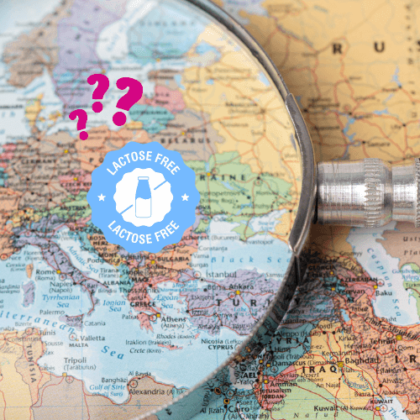
What is lactose? 🤔
The lactose is the sugar (or carbohydrate) in milk. It is a complex sugar (disaccharide), which can only be digested if it is converted into simple sugars (glucose + galactose).
This transformation is achieved by the enzyme lactase (in the small intestine) and makes lactose (broken down into lactic acid) which can be absorbed by the digestive tract.
When we think of lactose, we think of dairy products, but also of the difficulty some people have in digesting them. In fact, many of us are lactose intolerant and have difficulty digesting dairy products. suffer digestive problems of varying severity. To better understand lactose intolerance, it's important to understand what lactose is and what it does to our bodies.
Lactose: definition
First of all, lactose must be clearly distinguished from lactase. Lactose is a sugar, whereas lactase is an enzyme.
To be more precise, lactose is the milk sugar. It is a "complex" sugar that can only be properly digested if it is broken down into the two simple sugars glucose and galactose. To do this, our bodies need an enzyme called lactase. This enzyme is produced in the small intestine so that when we eat products containing lactose, it can be assimilated by the digestive tract.
What is the action of lactase on lactose?
Lactase is an enzyme produced by humans and all mammals in the small intestine. Lactase converts lactose into simple sugars that our body can easily digest. Lactase is therefore essential for digesting milk properly.
In the body of a newborn, lactase is at its highest level. As we grow, the amount of the enzyme gradually decreases to a residual level of only 5 to 10% in adulthood.
Why does our body have difficulty tolerating lactose?
As you can see, the older we get, the less lactase our bodies produce. As a result, it becomes more difficult to assimilate lactose, found in dairy products in particular (sometimes hidden). This lactose intolerance is in fact the norm, since we know that our prehistoric ancestors no longer produced lactase after weaning.
10,000 years ago, the peoples of the Caucasus began to consume milk from their farms. Gradually, these individuals became more tolerant of lactose and passed on this genetic mutation to their descendants.
Today, intolerance is still in the majority. In an adult population, lactase production is marginal. Worldwide, 75% of people are lactose intolerant (50 to 80% of the population of South America, 60 to 80% in Black Africa and 95% in Asia).
Lactose intolerance lactose intolerance is therefore 'normal' worldwide, but a minority in Europe, where, taking all degrees of intolerance together, lactose intolerant people represent around 40% of the population. In France, 5 million people are affected in their daily lives, so you're not alone! 😉
What is lactose intolerance?
All in all, lactose intolerance is the inability to digest lactoseThis is because the body no longer produces enough lactase, the digestive enzyme that breaks down lactose into digestible simple sugars.
In people withlactose intolerancelactose, the undecomposed lactose will ferment in the digestive tract and cause discomfort and inconvenience associated with poor digestion.
How to identify and avoid lactose in case of intolerance?
Lactose is, of course, present - at varying levels. in dairy products. However, this is not the end of the story, it can also be found in processed products or in some medicines and in 100% contraceptive pillsfor example. We don't always suspect it, but charcuterie, for example, can contain lactose (lardons, pâtés, merguez sausages, white pudding, sausages, etc.).
It can be difficult to manage lactose intolerance on a day-to-day basis, but you should know that the law requires all products to be labelled in bold with all allergens, including milk. So you can enjoy products containing lactose with complete peace of mind, you can opt for the lactase supplementation offered by Lactolérance.
➡️ Click here to discover our food supplements
How does lactose intolerance manifest itself?
From digestive problems of varying degrees may appear, depending on the amount of lactose absorbed and the sensitivity of each individual, such as :
- borborygma (stomach rumbling),
- abdominal swelling,
- stomach upsets (heartburn, abdominal cramps),
- bloating and flatulence,
- diarrhoea - sometimes also: nausea and vomiting, even gastro-oesophageal reflux, constipation, chronic fatigue and migraines.
These digestion problems generally appear between 15 minutes and 4 hours (sometimes up to 24 hours) after drinking milk-based beverages (a glass of fresh milk, whole or semi-skimmed milk, including powdered milk, small quantities of goat's milk or breast milk, but sometimes a simple chocolate milk will suffice) or ingesting products containing lactose (fresh cheeses, mature cheeses, hard cheeses, industrial yoghurts, but also cold meats, ice creams - and even certain medicines that use lactose as an excipient!)
What is the difference between lactose intolerance and lactose allergy?
Intolerance (failure to assimilate lactose), which may be hereditary, should not be confused with allergy to cow's milk, which involves a strong immune system reaction to aggression. ⚠️
Lactose intolerance must also be distinguished from other diseases of the digestive system such as irritable bowel syndrome or irritable bowel syndrome, Crohn's disease and other food allergies (gluten allergy) or food intolerances (gluten intolerance).
And what about Lactolérance?
Lactolérance is a French brand and has been an expert in lactose intolerance since 2010.
Lactolerance offers solutions to improve lactose digestion to suit every lifestyle:
- Lactolérance 4500 & Lactolérance 9000, 2 dietary supplements based onlactase enzymewhich facilitate lactose digestion.
- Lactolerance 1Day1 dietary supplement based on probiotic lactase precursor strains
With Lactolérance, the days of gastrointestinal problems and diets are over - at last you can eat what you want, no questions asked!

Hello, I'm Vincent
Like you, I'm lactose intolerantI know exactly what you're going through and the difficulties you encounter on a daily basis. For over 10 years, I've been helping our customers to use our dietary supplements and giving advice and tips on how to improve their digestive comfort. I'm also a keen cook and gourmet, so you'll find my favourite recipes for a lactose-free diet in this blog.
Lactose intolerance is not inevitable! With LACTOLERANCE you can digest with complete peace of mind




